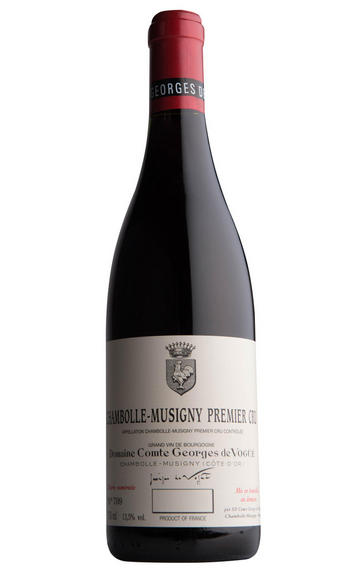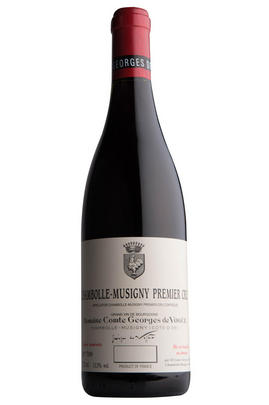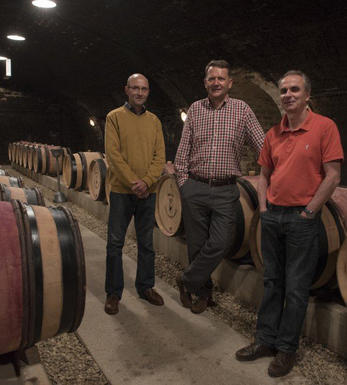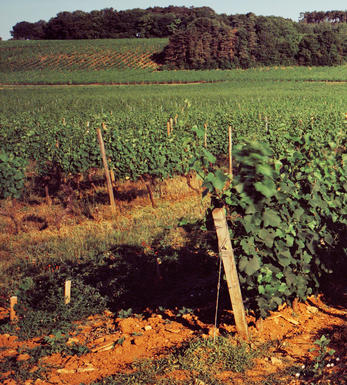
2013 Chambolle-Musigny, 1er Cru, Domaine Comte Georges de Vogüé, Burgundy

About this WINE

De Vogue
The Domaine Comte de Vogüé in Burgundy dates back to 1450 when Jean Moisson constructed the original building. The property stayed in the same family, passing through the female line from time to time until a Catherine Bouhier married Cerice-Melchior de Vogüé in 1766. Somehow the family, though in exile in England, managed to retain control of the domaine during the French revolution. Modern history and the current label begin with Comte Georges de Vogüé who took over in 1925. The first heyday of the domaine came during the 1940s, 1950s and 1960s. The domaine owns 7.25 hectares of the fabled Le Musigny vineyard which constitutes 80% of the whole site. In addition, it has 2.75 hectares of Bonnes-Mares and 1.8 hectares of Premier Cru Chambolle-Musigny.
Under the aegis of estate manager Jean-Luc Pepin, with winemaker François Millet and the aptly named Eric Bourgogne in the vineyards, this domaine currently cannot put a foot wrong; it ranks amongst the very best Burgundy houses. Tastings at de Vogüé have become a perverse highlight of any buying trip - nobody is allowed to taste unless François is present. In his exemplary measured English François will distill the essence of each vintage in a mixture of metaphysical and anthropomorphic metaphors.
The average age of vines in Le Musigny is 40 years old and all is labelled as Vieilles Vignes. This is Red Burgundy at its sublime best - marvellously perfumed, rich, ripe fruit, perfectly balanced and exquisitely harmonious. The best wines will keep for up to 50 years.
The vineyards are run more or less organically by Eric Bourgogne and his team, though they do not claim organic status. There is a mix of guyot and cordon training, in either case pruned for low yields. In the cellar François Millet will adapt techniques to suit the year. He likes a cool pre-maceration since glycerol is enhanced during this phase. Thereafter the temperature during fermentation should not exceed 32-33ºc. The oak regime is light on new wood: typically 15% for the village Chambolle and 35% for the grands crus, occasionally a little more.
Jasper Morris MW, Burgundy Wine Director and author of the award-winning Inside Burgundy comprehensive handbook.

Chambolle Musigny
Chambolle produces the most elegant wines in the Côte de Nuits, having more active chalk and less clay in the soil than the other villages. The wines may be a little lighter in colour and less tannic than Gevrey-Chambertin but they have a sublime concentration of fruit. Village Chambolle-Musigny usually provides excellent value.
Le Musigny is one of the top half-dozen vineyards in Burgundy, producing wines of extraordinary intensity and yet with a magical velvety character. Les Amoureuses is immediately appealing, a wonderfully sensual wine which deserves Grand Cru status. Bonnes Mares tends to have a firmer structure and ages very well
- 94 hectares of village Chambolle-Musigny.
- 61 hectares of Premier Cru vineyards (24 in all). The finest vineyards include Les Amoureuses, Les Charmes, Les Fuées, Les Baudes and Sentiers.
- 24 hectares of Grand Cru vineyard - Bonnes Mares and Le Musigny.
- Recommended producers: de Vogüé, Mugnier, Roumier, Barthod.
- Recommended restaurant: Le Chambolle

Pinot Noir
Pinot Noir is probably the most frustrating, and at times infuriating, wine grape in the world. However when it is successful, it can produce some of the most sublime wines known to man. This thin-skinned grape which grows in small, tight bunches performs well on well-drained, deepish limestone based subsoils as are found on Burgundy's Côte d'Or.
Pinot Noir is more susceptible than other varieties to over cropping - concentration and varietal character disappear rapidly if yields are excessive and yields as little as 25hl/ha are the norm for some climats of the Côte d`Or.
Because of the thinness of the skins, Pinot Noir wines are lighter in colour, body and tannins. However the best wines have grip, complexity and an intensity of fruit seldom found in wine from other grapes. Young Pinot Noir can smell almost sweet, redolent with freshly crushed raspberries, cherries and redcurrants. When mature, the best wines develop a sensuous, silky mouth feel with the fruit flavours deepening and gamey "sous-bois" nuances emerging.
The best examples are still found in Burgundy, although Pinot Noir`s key role in Champagne should not be forgotten. It is grown throughout the world with notable success in the Carneros and Russian River Valley districts of California, and the Martinborough and Central Otago regions of New Zealand.


Buying options
Add to wishlist
wine at a glance
Delivery and quality guarantee